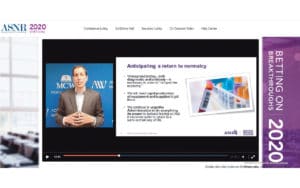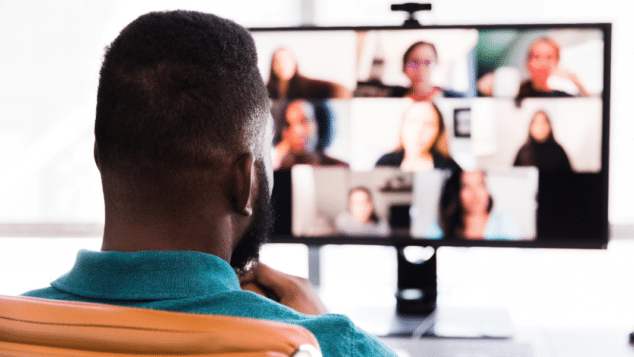Virtual Adventure

The American Society of Neuroradiology (ASNR) has a reputation for putting on impactful annual meetings. This year, the 2019–2020 ASNR annual meeting (#ASNR20) surpassed all expectations to become one of the most successful meetings in the society’s history. Originally planned as an in-person meeting to be held in Las Vegas from May 30–June 4, the organization had to quickly pivot to a virtual version once the COVID-19 pandemic became a reality.
Bringing New Life to the Familiar
When Dr. Joshua Hirsch took on the role as program chair of #ASNR20, he thought its robust academic base could expand to include new vendor partners, untapped participant markets and a greater level of buzz on social media. ASNR Executive Director Mary Beth Hepp had recently hired Director of Education Erica Kruse and Meetings Director Lynn Brown. Hirsch points out that rather than seeing new hires as a challenge, it allowed the group to think creatively right from the outset. With board support, this team set out to reenergize the program and break a few records in the process. An operations group was quickly formed by a strong subset of volunteers and staff. “This working group had an amazing symbiosis. To accomplish our goals, we had to rethink the way we planned, organized and marketed the meeting and symposium,” Hirsch states. “#ASNR20 added new tracks, deepened the scope of the event, created multiple new partner opportunities, and made a concerted effort to get the schedule and abstract topics out earlier to members, nonmembers and vendors — both nationally and internationally. We held nothing back.”
Embracing New Ideas
An important charge of the newly formed operations committee was curating and finalizing a program much earlier than in the past. Kruse notes that there were “many obvious advantages to prioritizing the final schedule early on in the process. It allowed for speaker/moderator travel planning, the ability to advance market the program and the early filling of the room block.” Further, the agenda highlighted the upgraded content of the meeting.
The group had added more continuing education and planned new networking opportunities for attendees, such as a reunion night. They also added several partner benefits including VIP get-togethers and innovation theater sessions. Other strategic changes addressed logistics such as menu planning, new badging, signage, staging and more.
Soon, it became clear that the meeting was going to break records for the society. As this was a new version of the event, very aggressive parameters had been set for many metrics including vendor partnership. Hepp says, “The response by industry sponsors was fantastic, with #ASNR20 positioned to be the highest sponsor-based, revenue-producing meeting in the society’s history by a remarkably wide margin.” Early registration suggested that more than 2,000 attendees would be present, closing in on a societal record set at its 50-year celebratory meeting.
Enter the Pandemic
“It was probably around February when we started to wonder about our ability to host an in-person meeting,” Hirsch explains. “When COVID-19 first showed up in Wuhan, China, we realized participants from that region weren’t going to be able to make the trip in numbers. Then the virus hit Europe, and it became obvious that European involvement was not going to be at the levels we had anticipated. Despite these realities, we still hoped that #ASNR20 could still be a live meeting. By March, however, it became apparent that the world had changed, and an in-person meeting in Vegas was going to be, at the very least, challenging.”
Moving forward
The decision to make the meeting virtual was not made lightly. Other options existed, including pausing the conference this year and starting over again in 2021. ASNR took a different path. “We had put so much energy into creating the Vegas meeting that it was hard to walk away from it,” Hirsch states. “As the biggest booster on the volunteer side, I felt like I had to be the first one to say the words out loud: We need to once again reimagine #ASNR20 and go virtual.” Moving forward would require intense teamwork and support across the board, with everyone figuring out the various logistics involved, including contract legalities, policies, technology, marketing, training — all under a time crunch.
Contract legalities: “Our first step was to call Caesar’s Palace to figure out how to move forward in a way that didn’t penalize the society or the hotel. Thanks to the good relationship that Lynn Brown had developed with her contact at Caesar’s, she was able to renegotiate the details of the contract in a way that all parties were satisfied and that received full support of our board,” Hirsch explains. Adds Brown, “I think that dealing one-on-one with our contact and having calm conversations on how we are all in this together helped us find a win-win for both the hotel and for the society.”
Policies: The board agreed from the onset that ASNR would operate utilizing the “good will” principle. Anyone who wanted a refund — registrants or vendors — would be given 100% of their money back. Registrants were given several options, including the ability to roll over their fee for next year’s live meeting. Vendors were offered a free virtual booth at #ASNR20 if they applied their current fees to an in-person booth next year. If a vendor wanted a refund, they could buy a virtual booth this year for $1,000.
Technology: Hirsch says, “ASNR has been thinking about adding virtual components to its offerings for some time now. Today’s technology enables options that would not have been possible before: You could have wanted to do a virtual meeting 10 years ago, but the tools weren’t there. The sledgehammer of a global pandemic has helped us to overcome technological trepidations to open up other opportunities.”

An ASNR virtual event session
A key component to being able to shift the meeting from in-person to virtual was finding the right technological engine to host the event. “I think our ability to maneuver so quickly was due to the fact that Kruse jumped in and set up appointments with several different companies to try out their platforms before it became obvious that we were headed in this direction,” Hepp says. They chose vConferenceOnline to customize their event. “We wanted to have all of our options vetted and ready to go once we made a decision. This legwork put us ahead of other associations who were also moving to a virtual meeting as we were able to be put on the build schedule for platforms before the companies were all booked up,” she says. The organization streamlined the amount of content and turned the abstracts into e-posters — increasing the number from 400 entries to 1,000.
Marketing: “Our next step was to get the word out to all meeting stakeholders,” Kruse explains. “We already had a communication system in place for all of our COVID-19 messaging. We used vehicles such as email, Twitter, Facebook and our website to educate registrants, speakers, vendors and the like on moving virtual. We sought creative partnerships with other societies in the radiology and neuroradiology space. We wound up increasing registration — particularly internationally — to over 4,400 participants. Our nonmember attendance soared to 45% of the total.” The team credits ease of access as the primary driver, together with setting the right price point and managing the content so that it was plentiful without being overwhelming. The hashtag “#ASNR” saw more than 15 million impressions, confirming that the marketing was successful.
Sponsor realignment: “You have to reset your expectations on what is appropriate for a sponsorship. For example, one of our sponsorships involved a company distributing the Wi-Fi password in Vegas, so things like that needed to be updated,” Hepp explains.
Training: A great deal of time and training went into helping speakers learn the technology needed to give their presentations: recording the speech, uploading it onto the platform, using slides to enhance the lecture and being able to handle questions/answers during the session. Recording lectures is not as easy as getting on a Zoom chat. Be prepared to work with speakers and their varying technology levels. In addition, participants needed to be able to interact with the conference platform in order to view the presentations and navigate the meeting to meet their individual needs. Fortunately, ASNR had a 95% retention rate for their bench of speakers.
Keys to Success
Teamwork is the foundation. You must have a tight working relationship between volunteer leadership and association staff. Without that trust and transparency, an organization may not be agile enough to face this type of challenge.
Flexibility is key. Moving this meeting online was new to everyone. “We were all figuring out things together in this new world — staff, vendors, speakers,” Hirsch says. “We had to have patience and work to find mutually workable solutions.”
Follow-up is important. Hepp notes that one of the most important aspects of this meeting is the “after market.” Available for download, participants can view the content that was most important to them for 90 days post-event. In addition, individuals who were not able to attend can purchase access to the content. “We found that one-third of participants joined us in real time, one-third will be watching on demand, and the last third pursued a hybrid of IRL and on-demand,” Hepp notes.
Hirsch, Hepp, Brown and Kruse all agree that the dynamics of this year, their ability to embrace uncertainty and the extremely successful pivot to a virtual meeting have changed the organization fundamentally. Hirsch, now ASNR president, states, “While this virtual adventure came about for unfortunate reasons, distance learning is something ASNR will embrace. I believe #ASNR20 proved to be inspirational, fostering connections and providing breakthrough learning.” 
![]() BECOME A VIRTUAL EVENT EXPERT. Learn more at on Association Forum’s Ignite the Restart page.
BECOME A VIRTUAL EVENT EXPERT. Learn more at on Association Forum’s Ignite the Restart page.
Tags
Related Articles
What to Wear to the Honors Gala 2025: SHINE ON in Style
Get ready to sparkle, shimmer, and most importantly—shine! Association Forum’s Honors Gala 2025 is on…
Double Your Footprint: Enhancing Conferences with a Hybrid Event Workflow
By combining on-site engagement with a digital experience, hybrid events can attract diverse audiences, boost...
The Emergency Nurses Association Utilizes Design Thinking to Reimagine its Awards Ceremony
In a prime example of intrapreneurship, the ENA utilized design thinking to innovate within the...




